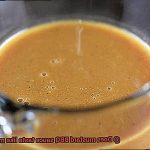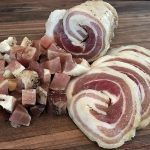Picture this: a sizzling pan, a fragrant kitchen, and the promise of succulent pork. Ah, the wonders of slow cooking. But here’s the conundrum we face: does pork truly become more tender as it simmers away?
As you stand there, stirring your simmering creation, you can’t help but wonder if time is working its magic on that slab of meat. Will it emerge from its bubbling bath transformed into a melt-in-your-mouth masterpiece?
Join me on this culinary adventure as we dive deep into the mysteries of pork tenderness. We’ll uncover the secrets behind texture transformation, explore the factors that influence tenderness, and arm you with knowledge to take your cooking game to new heights. So grab your apron and get ready to unlock the juicy truth about simmering pork to perfection.
Contents
What is Simmering?
Cooking pork to perfection can be a challenge, but there’s a technique that can transform tough cuts into succulent masterpieces – simmering. In this article, we’ll explore the concept of simmering and how it can be used to tenderize pork. So, put on your apron and let’s dive into the world of simmering.
What is Simmering?
Simmering is a slow and gentle cooking technique that involves cooking food in a liquid at a low temperature, just below boiling. By maintaining the liquid at a simmer, typically around 180-205°F (82-96°C), tough cuts of pork can be transformed into tender and juicy delights.
Tenderizing through Simmering:
Simmering works its magic by breaking down tough connective tissues in the meat. As the pork simmers in a liquid like broth, water, or sauce, the collagen in the meat converts into gelatin. This not only tenderizes the meat but also adds richness and moisture to the dish.
Tips for Simmering Pork:
- Choose the right cuts: Tougher cuts like shoulder or butt benefit the most from simmering. However, more tender cuts like tenderloin or chops can also be simmered for enhanced flavor.
- Low and slow: Simmering requires patience. Cook your pork over low heat for an extended period to allow collagen to break down gradually.
- Infuse with flavors: Take advantage of simmering by adding herbs, spices, and acidic ingredients like vinegar or wine to enhance tenderness and flavor.
- Monitor closely: Keep an eye on the process to prevent overcooking or excessive evaporation. Adjust heat levels as needed and add more liquid if necessary.
- Rest before serving: Let your pork rest for a few minutes after simmering. This allows the juices to redistribute, resulting in a more flavorful and tender final product.

How Does Simmering Affect Pork Tenderness?
Simmering is like a gentle spa treatment for your pork, slowly transforming it into a succulent delight. But how does simmering work its magic? Let me break it down for you:
- Collagen breakdown: Pork contains collagen, a tough protein that gives the meat structure. Simmering breaks down collagen into gelatin, adding moisture and tenderness to your pork.
- Slow and even cooking: Simmering allows pork to cook slowly and evenly, preventing toughness and dryness. Patience is key here.
- The longer, the better (up to a point): Simmering pork for longer periods allows more time for collagen breakdown and tenderness. But be cautious not to overcook – too much simmering can turn pork into mush or dry it out.
- Flavor infusion: Simmering not only tenderizes meat but also infuses flavors from the liquid and added ingredients. Imagine your pork soaking up those delicious flavors like a sponge.
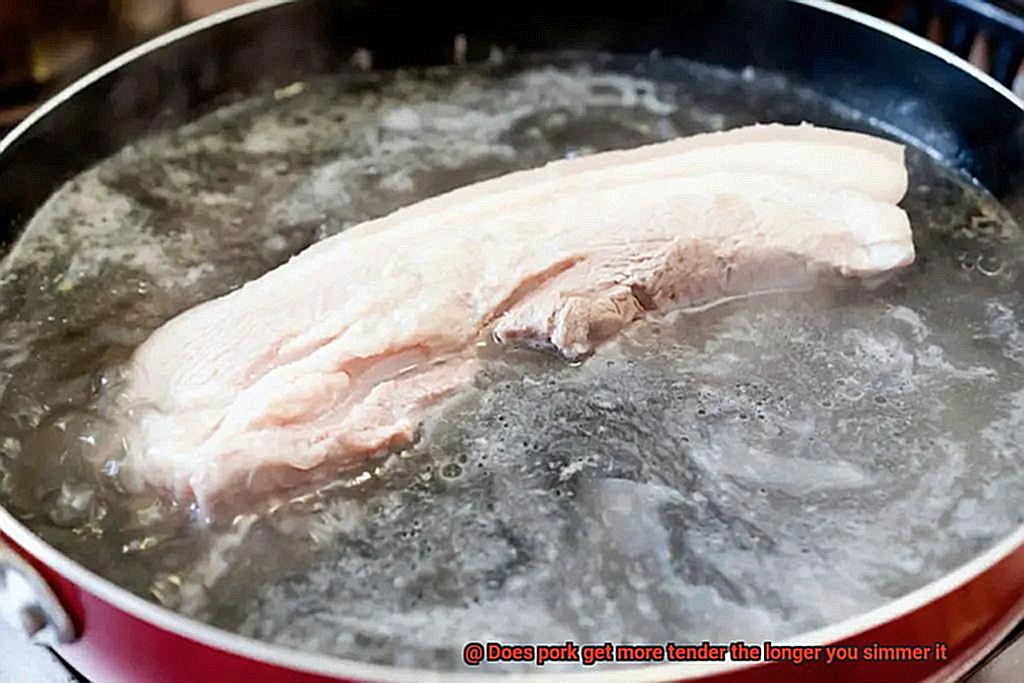
To make your simmered pork even more delectable, here are some tips:
- Use flavorful liquids like broth, wine, or spices and herbs to enhance taste.
- Add acidity: Vinegar or citrus juice in the simmering liquid speeds up collagen breakdown for even more tenderness.
- Sear before simmering: A quick sear creates a caramelized crust on the outside of the pork, adding depth and richness.
- Let it rest: After simmering, let your pork rest to redistribute juices throughout the meat for moist and flavorful results.
What Are The Different Cuts of Pork?
Calling all grill masters. If you’re a fan of pork, then you’re in for a treat. Understanding the different cuts of pork and their best cooking methods for grilling will take your backyard barbecues to a whole new level. So grab your tongs, fire up the grill, and let’s dive into the world of pork cuts.
Pork Shoulder:
Let’s start with a cut that’s perfect for low and slow cooking: the pork shoulder. Also known as pork butt or Boston butt, this flavorful cut is ideal for braising or simmering. The longer cooking time helps break down tough connective tissues, resulting in tender and juicy meat. Use it to make mouthwatering pulled pork, stews, or carnitas.
Pork Loin:
Next up, we have the versatile pork loin. This lean and tender cut can be divided into two main sections: the back ribs and the center-cut roast. The center-cut roast, which is boneless, is excellent for roasting or grilling. On the other hand, the back ribs are perfect for low and slow cooking or smoking. Get creative with this cut and prepare elegant dinners or casual weeknight meals.
Pork Tenderloin:
If you’re looking for a tender cut that cooks quickly, look no further than the pork tenderloin. This lean muscle lies beneath the loin and is best suited for high-heat cooking methods like grilling, pan-searing, or broiling. Marinate it to add flavor and enjoy it as a standalone main dish or sliced for sandwiches.
Pork Chops:
Ah, the classic pork chops. These beauties come from the loin section of the pig and can be bone-in or boneless. Thickness matters when it comes to grilling pork chops – thicker chops require more time on the heat. You can grill, pan-fry, or bake them to perfection. Experiment with different seasonings and sauces to find your favorite combination.
Spare Ribs:
If you’re a fan of finger-licking goodness, spare ribs are for you. These meaty ribs, found beneath the pork loin, are perfect for slow cooking methods like smoking or braising. Their larger size and higher fat content make them incredibly flavorful. Slather them in a tangy barbecue sauce and let the grill work its magic.
Bacon:
Last but certainly not least, we have the superstar of the pork world – bacon. Made from the belly of the pig, bacon is a beloved favorite in countless dishes. It can be fried, baked, or even grilled to add a savory and smoky flavor. Let your creativity run wild with bacon-wrapped delights or simply savor it on its own.
How Long Should You Simmer Pork For?
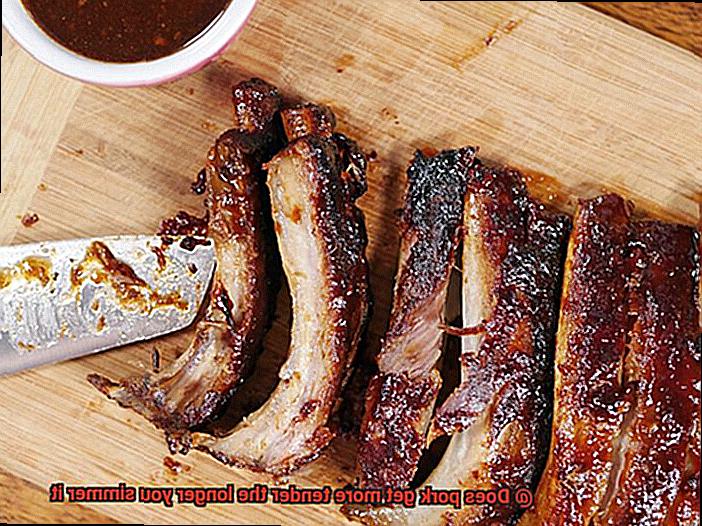
Are you ready to take your pork cooking skills to a whole new level? Simmering is the secret technique that will elevate your pork dishes to tender, flavorful perfection. But how long should you simmer that succulent piece of pork for? Fear not, my friends. Today, we embark on a journey to explore the depths of simmering times, ensuring that your pork emerges as a masterpiece of taste and texture.
Tough Cuts: Embrace the Zen of Patience
For those tough cuts like shoulder or butt, prepare to channel your inner Zen master. These cuts are packed with flavor, but they require a little extra TLC. To transform them into juicy perfection, simmer them for a minimum of 2-3 hours. During this slow cooking extravaganza, the connective tissues and collagen will break down, resulting in tender, melt-in-your-mouth goodness.
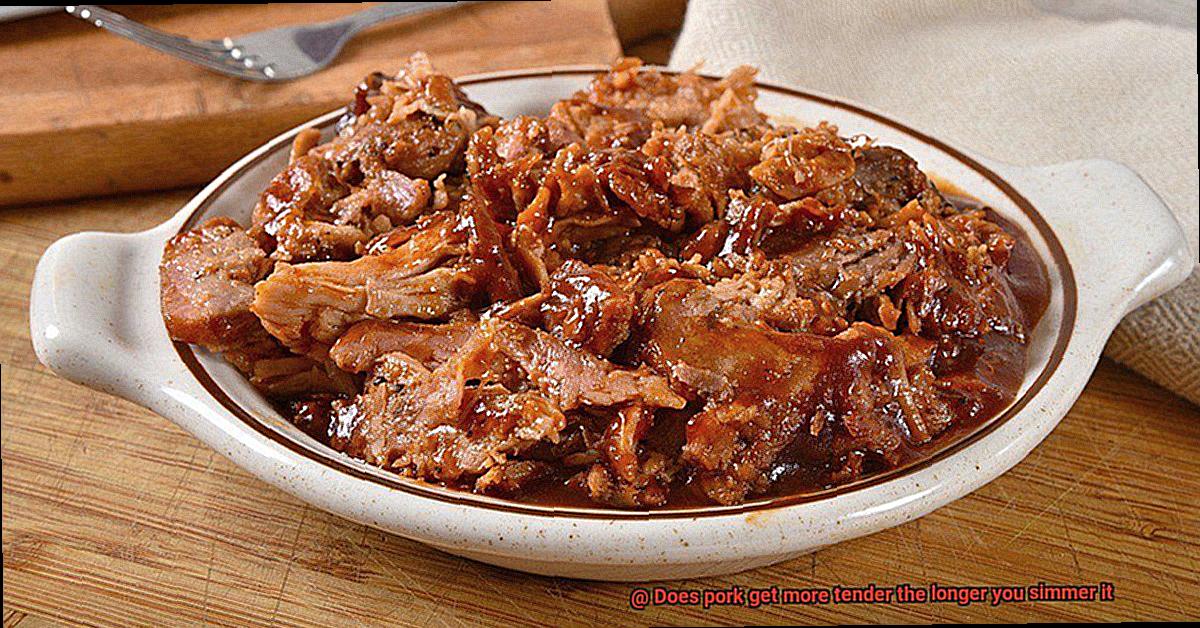
Lean Cuts: Quick and Delectable
Now let’s turn our attention to the leaner cuts like tenderloin or chops. These beauties are naturally tender and don’t require as much simmering time. In fact, 30-40 minutes of simmering is all it takes to enhance their flavors without turning them into chewy shoe soles. Remember, we want to preserve their tenderness while infusing them with deliciousness.
Experimentation: Unleash Your Culinary Creativity
Cooking is an art form, my friends, and sometimes you have to play around to discover your perfect masterpiece. Don’t be afraid to experiment with different simmering times. Perhaps you prefer your pork a little firmer or falling-off-the-bone tender. Adjust those simmering times to suit your wildest taste bud dreams and unleash your culinary creativity.
Tips and Tricks:
- Harness the Power of the Meat Thermometer: Don’t leave your pork’s tenderness up to chance – invest in a good meat thermometer. It’s like having a culinary superhero by your side, ensuring that you achieve the desired level of doneness every time.
- The Fork Test: If you don’t have a meat thermometer at hand, fear not. You can still gauge the tenderness of your pork by gently poking it with a fork. If it slides in easily and releases with little resistance, you’re good to go.
What Are The Dangers Of Overcooking Pork?
Picture this: you eagerly take a bite of your once succulent pork, only to be met with a dry, tough, and rubbery texture. Not exactly the mouthwatering experience you were hoping for, right?
The proteins in pork tighten up when exposed to high heat, causing them to squeeze out all the moisture. This leads to the dreaded chewiness and rubberiness that can ruin a perfectly good meal.
But it doesn’t stop there. Overcooking also strips the pork of its natural flavors, leaving it bland and unappetizing. Instead of that desirable pinkish hue, overcooked pork can end up with a sad and unappealing grayish color.
Excessive rendering of fat is another danger of overcooking. Your mouth will be left feeling greasy and oily, far from the pleasant sensation you desire.
And here’s something that might make you think twice before overcooking your pork – it can lead to the formation of harmful carcinogens. Burning or charring the meat produces unpleasant flavors and potentially dangerous substances that are best avoided.
But perhaps the most alarming danger of overcooking is the increased risk of foodborne illnesses. The longer pork is cooked, the higher the chance it reaches unsafe internal temperatures. This can allow bacteria like salmonella or trichinosis to survive, posing a serious threat to your health.
Now, I’m not saying you should shy away from cooking pork altogether. Some cuts benefit from slow cooking methods like simmering. However, it’s crucial to exercise moderation and keep a close eye on the temperature gauge to ensure you don’t cross the line into overcooking territory.
What Ingredients Can Be Added To The Simmering Liquid To Enhance Flavor And Tenderness?
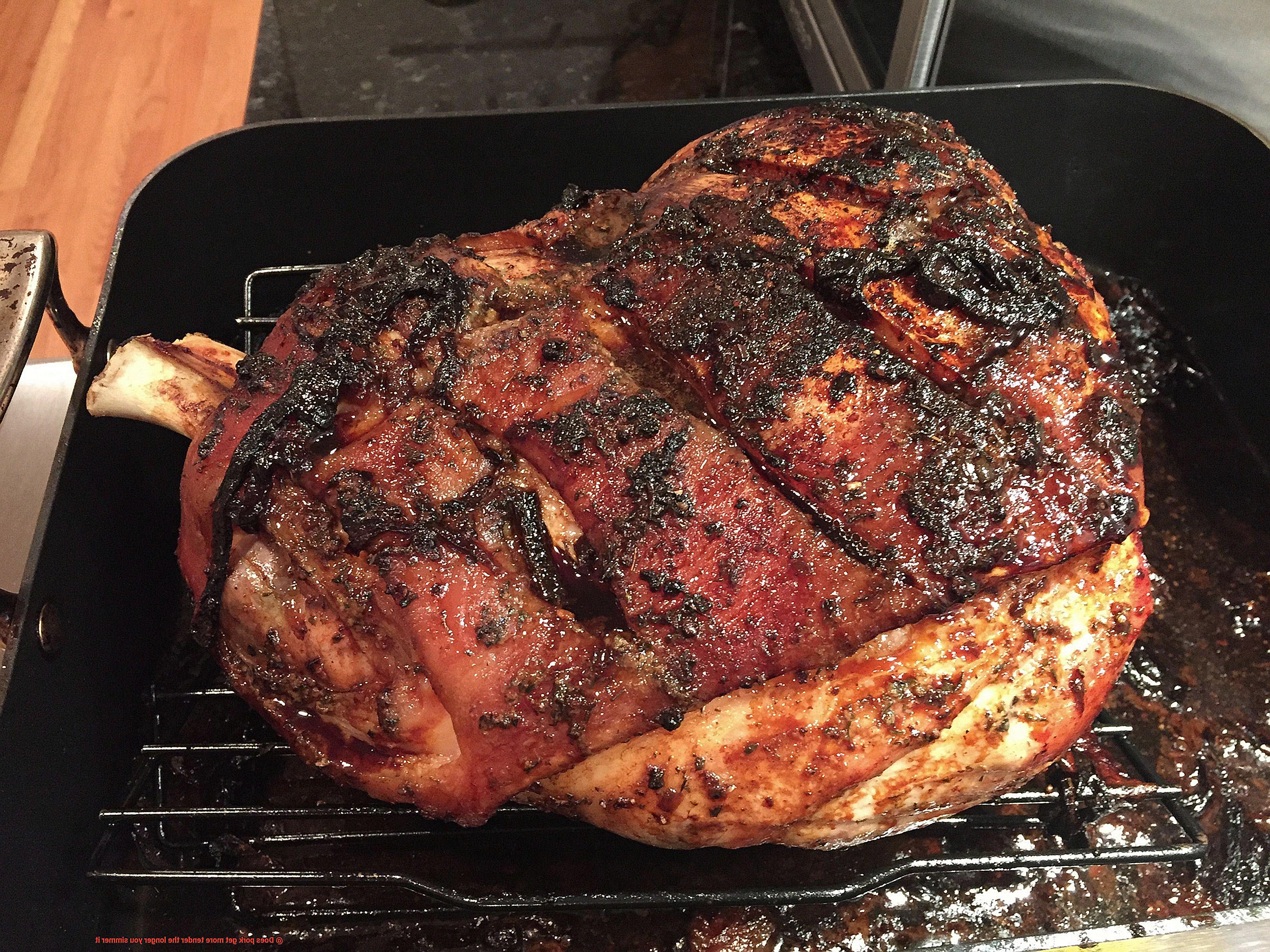
Imagine the sizzle of a backyard barbecue, the tantalizing smell of marinated pork wafting through the air. You want your pork to be more than just flavorful; you want it to be tender and juicy, melting in your mouth with every bite. The secret lies in the simmering liquid. By adding carefully selected ingredients to your simmering liquid, you can take the flavor profile of your pork to new heights and achieve unparalleled tenderness that will leave your guests craving for more.
Aromatics: Unleashing Fragrant Flavors
Let’s start with the basics – aromatics. Onions, garlic, and a bouquet of herbs like thyme, rosemary, and bay leaves form the foundation of flavor. As they infuse into the simmering liquid, they release their aromatic qualities, transforming ordinary pork into a symphony of tastes.
Acidity: The Key to Tenderization
To tenderize tough fibers and enhance tenderness, introducing acidity is crucial. A splash of vinegar or citrus juice like lemon or lime works wonders. The acid helps break down the meat’s connective tissues while adding a bright and refreshing flavor that cuts through richness.
Broth or Stock: The Essence of Liquid Gold
For an extra depth of flavor, opt for a rich chicken, beef, or vegetable broth as your simmering liquid base. These stocks are made by simmering bones and vegetables for an extended period, extracting their flavors and nutrients. The result? A luscious liquid that infuses your pork with unparalleled deliciousness.
Umami: Unveiling Savory Secrets
Soy sauce and Worcestershire sauce are umami powerhouses. Adding them to your simmering liquid not only enhances flavor but also helps tenderize the meat due to their high salt content. Prepare for a burst of savory goodness that will make your taste buds dance with delight.
Sweetness: Striking the Perfect Balance
To balance out any acidity and add a touch of caramelized flavor, don’t forget to incorporate sugar or sweeteners like honey or brown sugar. This subtle sweetness elevates the overall taste profile of your pork and makes it simply irresistible.
Spices and Seasonings: The Finishing Touch
Last but not least, don’t be afraid to experiment with spices and seasonings. Paprika, cumin, chili powder, or black pepper can add a hint of heat, smokiness, or complexity to your simmering liquid. These bold flavors will take your pork from ordinary to extraordinary.
What Alternative Methods Can Be Used To Achieve Tender Pork?
Well, fret no more. I’ve got some alternative methods up my sleeve that will have your pork tender and juicy every single time. So, don your apron and get ready to dive into the tantalizing world of tenderizing techniques.
First and foremost, let’s talk about marinating. This method is a game-changer when it comes to achieving tender pork. By immersing your meat in a flavorful concoction of acidic liquids like vinegar or citrus juice, you’ll witness some magic happening. These acidic components work their wonders by breaking down those pesky muscle fibers, resulting in a succulent and tender texture. But wait, there’s more. You can also add a medley of herbs, spices, and oils to infuse even more mind-blowing flavor into your pork.
Now, let’s move on to brining. Prepare to be amazed as we submerge our pork in a salty water solution. The salt acts as a moisture-retaining superhero during the cooking process, ensuring that your pork emerges from its culinary adventure with unparalleled juiciness and tenderness. And hey, why not take it up a notch? Throw in some sugar or other flavorings to the brine for an extra kick of mouthwatering deliciousness.
If you’re not one to rush through life, slow cooking is about to become your ultimate best friend. Picture this: a slow cooker or a covered pot gently simmering away on low heat, transforming your pork into a melt-in-your-mouth delicacy. This method allows the collagen in the meat to break down ever so slowly, resulting in an unparalleled tenderness that will make your taste buds sing with joy. Plus, with all that time on its side, the flavors have ample opportunity to develop and penetrate every inch of the meat.
But what if time isn’t on your side? Fear not. Enter the pressure cooker, your knight in shining armor. This kitchen gadget harnesses the power of high pressure and heat to swiftly break down those muscle fibers, leaving you with tender and flavorsome pork in a fraction of the time it takes with other methods. It’s like a magic wand for your pork.
Last but certainly not least, let’s not forget about the naturally tender cuts of pork. Think pork tenderloin or pork loin – these beauties require minimal effort to achieve tenderness. Simply cook them quickly at higher temperatures, allowing their natural juiciness and tenderness to shine through.
How Do You Know When Your Pork Is Cooked To Desired Tenderness?
The tantalizing sizzle of pork on the grill is a culinary delight. But how do you ensure your pork reaches that sublime level of tenderness? Today, we unveil the secrets to determining when your pork is cooked to your desired level of melt-in-your-mouth goodness. Grab your tongs and let’s embark on a journey to pork perfection.
Internal Temperature:
Let’s start with the backbone of pork mastery – internal temperature. The USDA recommends a minimum internal temperature of 145°F (63°C) for pork, but if you crave ultimate tenderness, you may want to cook it a bit longer. Equip yourself with a reliable meat thermometer and insert it into the thickest part of the meat, avoiding contact with any bones. This trusty gadget will be your ally in achieving pork perfection.
Juice Color:
Now, let’s explore the vibrant world of juicy secrets. When you slice into your pork, keep a watchful eye on the color of the juices. Clear or slightly pink juices indicate that your pork is fully cooked and tender. However, if they remain red or possess a reddish-pink hue, it’s a sign that further cooking is required. After all, no one desires chewy pork, right?
Texture Matters:
In the realm of pork mastery, texture reigns supreme. Make a small incision in the thickest part of the meat using a fork or knife and observe how effortlessly it separates. If the flesh is moist with a gentle springiness and cuts like butter, congratulations. Your pork is likely done or nearing perfection. However, if it feels firm and resists being cut through, it yearns for more time on the heat.
Different Cuts, Different Techniques:
Remember, each cut of pork demands its own unique cooking time and technique. Lean cuts like tenderloin or loin chops can quickly become dry, so vigilance is key. Conversely, cuts with more fat and connective tissue, such as pork shoulder or ribs, thrive under low and slow cooking. The gentle heat breaks down collagen, instilling tenderness and succulence to the meat.
kE2qCAh7Xxw” >
Conclusion
In conclusion, the longer you simmer pork, the more tender it becomes.
Simmering allows the collagen in the meat to break down and transform into gelatin, resulting in a melt-in-your-mouth texture. The slow cooking process also allows the flavors to develop and infuse into every bite.
So next time you’re preparing pork, be patient and let it simmer away for ultimate tenderness and flavor.


